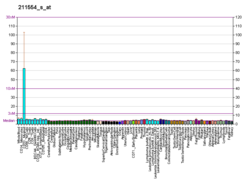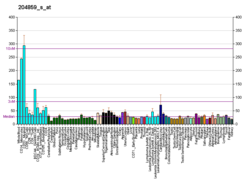Top Qs
Timeline
Chat
Perspective
APAF1
Mammalian protein found in Homo sapiens From Wikipedia, the free encyclopedia
Remove ads
Apoptotic protease activating factor 1, also known as APAF1, is a human homolog of C. elegans CED-4 gene.[5][6][7]
Remove ads
Function
The protein was identified in the laboratory of Xiaodong Wang as an activator of caspase-3 in the presence of cytochromeC and dATP.[8] This gene encodes a cytoplasmic protein that forms one of the central hubs in the apoptosis regulatory network. This protein contains (from the N terminal) a caspase recruitment domain (CARD), an ATPase domain (NB-ARC), few short helical domains and then several copies of the WD40 repeat domain. Upon binding cytochrome c and dATP, this protein forms an oligomeric apoptosome. The apoptosome binds and cleaves Procaspase-9 protein, releasing its mature, activated form. The precise mechanism for this reaction is still debated though work published by Guy Salvesen suggests that the apoptosome may induce caspase-9 dimerization and subsequent autocatalysis.[9] Activated caspase-9 stimulates the subsequent caspase cascade that commits the cell to apoptosis.[citation needed]
Alternative splicing results in several transcript variants encoding different isoforms.[5]
Remove ads
Structure
APAF1 contains a CARD domain with a Greek key motif composed of six helices, a Rossman fold nucleotide binding domains, a short helical motif and a winged-helix domain.[10]
Interactions
APAF1 has been shown to interact with:
References
Further reading
Wikiwand - on
Seamless Wikipedia browsing. On steroids.
Remove ads









